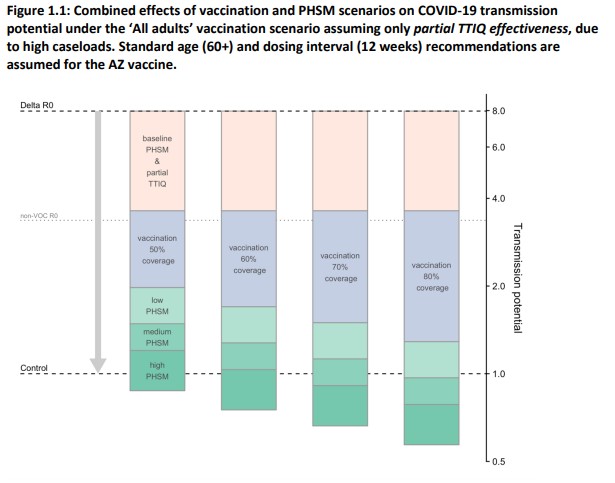The Covid19 outbreak in NSW continues to grow despite a gradually tightening lockdown. The current doubling time is about 11 days, meaning that my simple model is projecting 1,000 cases a day by the end of August. It seems the only way out is vaccination. How much vaccination?
The Doherty Institute modelling suggests that 60% full vaccination coverage of the adult population is needed to stop this NSW outbreak continuing to grow with the current level of restrictions, and 80% full adult vaccination coverage before growth would stop even with restrictions eased back to those that were in place in August 2020 (open restaurants, gyms and cafés, but with wide spacing and generally no more than 100 people in any one venue). On current vaccination rates in NSW, that 80% level would occur in the middle of November 2021.
The Doherty Institute officially modelled vaccination rates for the Australian government in this analysis here. The key diagram is this one:
This shows how all the various measures for restriction of a virus can be combined to bring the transmission potential under 1 – ie each infected person infects fewer than one person. It starts with a R0 (the number of people each person will infect, on average, without any restrictions) of 8 (at the top end of estimates for the Delta variant) and looks at the various measures that can be taken to bring the transmission potential down.
The key message to note is how much of the heavy lifting is being taken by things other than vaccination, even in the 80% (of the adult population) coverage scenario. The reduction in the Rf from 80% vaccination coverage is only 2.3 of the 7.0 reduction to get from 8.0 to 1.0. To get the Rf below 1.0, even with that level of vaccination, we still need quite substantial levels of restriction in people’s movements – equivalent to NSW in August last year.
In NSW on 14 August, 27% of the adult (over 16) population has been fully vaccinated, and 52% has received at least one dose. On the scale in the graph above (see below for the calcs), that suggests that right now, vaccination might be reducing the R0 by half of the 50% coverage in the diagram – ie around 0.7. The Doherty simulations are clear that with a delta variant, even 50% full adult vaccination coverage is not enough to reduce the Reff to under 1 without more restrictions than NSW has at the moment.
- baseline PHSM & partial TTIQ – this is NSW’s level of restrictions in March 2021 – lots of people working from home, masks on public transport, but people could gather indoors if they followed the 2sqm rule – one person per 2 square metres. It also assumes that contact tracing and case quarantine (TTIQ) is only partially effective once an outbreak takes hold, which is what we are seeing now in NSW
- Vaccination coverage – the blue section of each bar shows the effect of each level of vaccination coverage of the adult population (AZ, taken 12 weeks apart, two weeks after the second dose) – to translate these coverages to the whole population 50/60/70/80 become 40/48/56/64 % of the total population.
- PHSM – low medium and high, for Australians, these are different levels of lockdowns that have occurred in different states.
- Low is NSW in August 2020 (4 sq metre rule, limited gatherings indoors, generally up to 100, eg my theatre performance was 25% full).
- Medium is NSW in early July 2021, with restaurants, cafes, hairdressers gyms etc closed, and indoor gatherings (such as weddings, funerals) stopped, but no real restriction on shopping, please work from home if you can
- High is Victoria in August 2020 (curfews, substantial reduction even in essential work, exercise and essential shopping limited to within 5km of your house
The key message to note is how much of the heavy lifting is being taken by measures other than vaccination, even in the 80% adult coverage scenario.
Some aspects of this modelling that I will return to:
- Any outputs you see from the Doherty Institute modelling of hospitalisations, ICU admissions and deaths, are done on the assumption that there are zero cases at the beginning. If we have 1,000 cases a day (or more) when we get to 80% adult vaccination rates, then the hospitalisations, ICU admissions and deaths will be much greater while the outbreak is brought under control
- The Doherty Institute was given the assumptions about vaccine efficacy against transmission by ATAGI. On first glance, they seem optimistic compared with the UK modelling.
- The modelling also assumes that NSW March 2021 restrictions and contact tracing bring the Delta Reff down from 8.0 to 3.6. The modelling was mostly completely before the NSW outbreak, but given how fast the NSW outbreak has spread, this assumption may need another look.
Links
How the pandemic now ends – How Delta has changed the endgame – the latest from the best writer about Covid19 – Ed Yong. He’s writing about the US, but very relevant to how things are happening here in Australia.
This new surge brings a jarring sense of déjà vu. America has fallen prey to many of the same self-destructive but alluring instincts that I identified last year. It went all in on one countermeasure—vaccines—and traded it off against masks and other protective measures. It succumbed to magical thinking by acting as if a variant that had ravaged India would spare a country where half the population still hadn’t been vaccinated.
Here, then, is the current pandemic dilemma: Vaccines remain the best way for individuals to protect themselves, but societies cannot treat vaccines as their only defense. And for now, unvaccinated pockets are still large enough to sustain Delta surges, which can overwhelm hospitals, shut down schools, and create more chances for even worse variants to emerge. To prevent those outcomes, “we need to take advantage of every single tool we have at our disposal,” Bansal said. These should include better ventilation to reduce the spread of the virus, rapid tests to catch early infections, and forms of social support such as paid sick leave, eviction moratoriums, and free isolation sites that allow infected people to stay away from others.
And an article from a group surveying vaccine hesitancy in Australia:
With outbreaks resulting in a prolonged lockdown for Sydney as well as shorter periods for other states, the proportion of Australians vaccinated has steadily increased while vaccine hesitancy has fallen. The latest survey data collected by the Melbourne Institute show vaccine hesitancy had fallen to 21.5% of the adult population at the end of July 2021, compared with 33% at the end of May 2021. But how much further can it fall?
Our data suggests there are qualitatively different types of vaccine hesitancy. The decline in vaccine hesitancy we have seen thus far is more about those who had just been “taking their time” rather than being steadfastly uncommitted. Worryingly, our analyses suggest there remains a significant proportion of the population whose resistance to vaccination will be hard to shift, regardless of the incentive.
Life Glimpses
This weekend the various restrictions in NSW tightened further, with the whole of Greater Sydney now restricted to a 5km radius (or in some cases, the local government area in which you live). I live in the local government area of North Sydney, and discovered on a bike ride this week that I don’t actually know where the borders are, when following a slightly different path, I suddenly found myself in the neighbouring council area of Willoughby. Because in my case my local government area is so small, I just have to stay within 5km of my house. The harder part is finding a ride that doesn’t involve a very steep hill at some point – I may get quite a lot fitter by the end of this lockdown.
And my latest TV viewing, ostensibly to practice my French, but mainly for the virtual travel from lockdown is The Parisian Agency, a reality show about an upmarket family real estate business in Paris. Reality TV seems so much more intellectual in another language!
Bit of beauty
Today’s bit of beauty is some cherry blossom from my daily walk (geekinsydney’s picture was better than mine). While we don’t have the cherry blossom tradition of Japan, at this time of year, there are a few beautiful trees dotted about the neighbourhood.



Love your bit of beauty. Too ignorant to understand the serious stuff.
Very hot here, shall I send some degrees
Great article and I am now closer to some sort of understanding of what I hear at 11am each morning!
Hi Jennifer and thanks again for sharing your thoughts. I wish you all well there, fearing that you are in for a long, slow improvement in vaccine numbers until “freedoms” in Sydney return. In Europe it is interesting to note the attempts to get from c.60% vaccinated to 80+% especially the French approach – making the fundamentals of Paris life (cafes, etc) dependent on vaccines is clearly a polarising position but are shown to be having the effect of pushing the % towards target, even higher than UK which seems to have stalled and is now more reliant on individual choices on masks and distancing to keep a reasonable R number.
Finally I welcome your French viewing choices and suggest (if not already) Lupin and Dix pour cent to remind you of life over here given the lack of travel.
Bon chance.
Hi Iain, it is lovely to hear from you as always. My french teacher (who is originally from Paris) is quite amazed at how many of his friends and family are anti vaccination, but does say that some of them think being able to go to cafes again is worth it.
I have already found and loved those series, (and the Bureau, quite a different tone!) but would love any other suggestions.